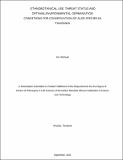| dc.description.abstract | The genus Aloe is known for its use in healthcare and cosmetics. Many Aloe species are globally
threatened due to over-harvesting for trade and habitat destruction. In Tanzania, over-exploitation
threats some Aloe species with extinction, and yet little has been documented on the abundance,
bio-cultural uses, threats, seed biology and appropriate conservation measures. Semi-structured
questionnaires were used to obtain ethnobotanical information and perception of Aloe species'
threat factors from 236 respondents in Kilimanjaro, Tanga, and Mara and Katavi-Rukwa regions.
Geospatial Conservation Assessment software (GeoCAT) was used to assess the Area of
Occupancy and Extent of Occurrence of Aloe species. The temperature, light, scarification, KNO3
and salinity among the Critically Endangered and the Least Concern Aloe species were tested to
understand optimal environmental conditions for their optimal growth. For the Critically
Endangered A. boscawenii, an ideal concentration for sterilization and rooting hormone were
determined to promote tissue cultivations. A total of 23 Aloe species were identified, with A.
secundiflora being the most widely used species. Malaria and general stomachache in humans,
and Newcastle disease in chickens were frequently treated with Aloe species. Among the 22 Aloe
species re-assessed, two were categorized as Critically Endangered, ten as Endangered, five as
Vulnerable, one as Nearly Threatened and five as Least Concern. Aloe boscawenii was re discovered after not having been seen for more than six decades. The conservation status of the
Aloe species endemic to Tanzania and previously categorized as Critically Endangered were
upgradeed. All the tested Aloe species germinated best at moderate temperatures (25°C and 30°C)
and low KNO3 levels (0.01 mg/L). The Critically Endangered A. boscawenii was successfully
regenerated through tissue culture at 6% of NaOCl and rooted at NAA: IBA (2:1) concentration.
The genus Aloe is widely used across Tanzania, as such 77% (N = 22) of Aloe species assessed
in this study are threatened, mainly due to human activities. Hence, there is a need to formulate
laws and policies to protect Aloe natural habitats. Moreover, the Aloe seeds exhibited species specific responses to various environmental conditions (except for A. pembana). Furthermore,
tissue culture is an ideal conservation tool for the threatened species as it outperforms the
traditional methods. | en_US |

